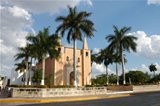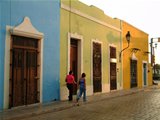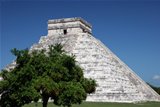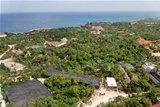The Cenote
A 'hole' lot of beauty
The cenote is an important and eye-catching geological feature of the Yucatan Peninsula. A marvel of nature where a simple swim turns into a soul-cleansing experience.
They are truly mystical places. The ancient Maya regarded them as sacred entrances to the underworld. Kind of a womb where everything dies and is reborn (that's why they at times practised human sacrifice and threw the bones in these sinkholes). Since very remote times cenotes have been gathering places for ritual offerings and worship.
Chemicals like suntan lotion or insect repellent should not be used for cenote swimming since they pollute the water.
We all have make our contribution to preserve these wonders of nature and the life in it (fish, small crustaceans).
Also don't forget that eventually these chemicals will filter from one sinkhole to the other affecting the source of drinking water for the people living there!
What exactly is a cenote?
It's sort of a fresh water pool, but it's not a lake, allthough it may look like one. In some cases the water can be brown or greenish, but mostly you'll find it to be crystal clear and transparent, almost as if there were no water at all, and you can see straight through to the rock formations below.
The Yucatan Peninsula is a porous limestone shelf with only inches of soil. The topsoil layer is so thin it doesn't retain rain water and no rivers could ever form on the surface.
Instead, the fresh water filters through to deeper levels and starts to eat away the rock, forming caverns with underground pools and "rivers". You can compare it to a subway system, where the different lines are the 'rivers' and the stations would be the underground basins where fresh water collects.
Typically, a cenote is not an isolated pool. Most are interconnected through subterraneous flows. Tests have proved that by introducing a dye in one sinkhole the water in others changes color.
In some cases, after millions of years the limestone ceiling gets so thin it gives away. An open well is formed, like the one in Chichen Itza. Other cenotes are completely or semi-underground. In some of them beams of sunlight coming through holes in the ceiling add to the magical atmosphere.
Mirrors of water
Actually the name Chichen Itza should be read as Chiche'en Itza, which is derived from the classic word che'en.
It's usually translated as 'the mouth of the well of the Itzaes', so as you can see the translation indeed is close to the original meaning, at least for the '-chen' part.
In classic Maya language the word for cenote was Che'en meaning 'mirror of water'.
The Spaniards later used a 16th century term they took from the Yucatan maya, dzonot, and hispanized it.
There are an estimated 7 to 8,000 dzonot on the peninsula, and that's only an educated guess. The largest concentration is found at the border of the Chicxulub crater in the Northwestern part of the peninsula.
Some are accessible for swimming, snorkeling and cave diving, others have yet to be discovered.
A few years ago someone bought a piece of land just outside Valladolid and by sheer happenstance found the entrance to a huge cavern, Suytun. He and his family opened it to the public for an entrance fee and they are now all very happy making nice profits.















